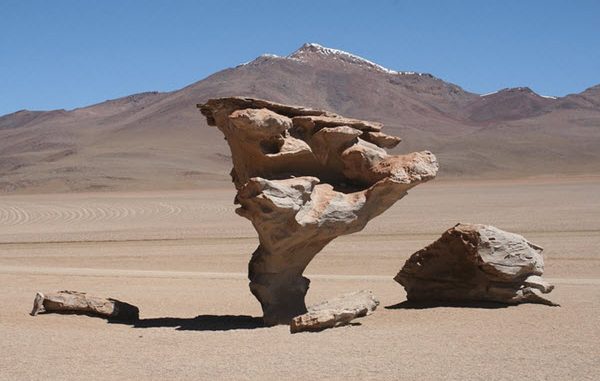
The Atacama Desert in Chile is one of the driest and most lifeless environments on our planet, but that doesn’t mean that it is completely devoid of life. And if life can exist even in such a harsh and unforgiving place as the Atacama Desert, then maybe it can – or could – exist on Mars as well?
Suitable candidates for surviving on Mars might be found in a community of bacteria recently discovered by researchers who ventured into the inhospitable Atacama Desert to collect samples. These bacteria can survive for at least a decade without water.
Collecting samples
“I like to go to places where people say nothing is alive,” says astrobiologist Dirk Schulze-Makuch from the Technical University of Berlin. “We decided to take a shotgun approach and throw all the new [analytical] approaches at everything—fungi, bacteria, viruses”.
Schulze-Makuch and his team visited eight different placed in the desert and collected samples from each of them, ranging from the Pacific coastal region in the west and eastward to the very driest spots. The gathering of samples, which was spread out over three years, started just a month after a record-setting rain in 2015. The team then returned to gather more samples from the same places in 2016 and 2017.
Looking for life
To find out what was in the samples, the team sequenced all the copies of a gene known to distinguish microbial species. The work went very well and they even managed to recover some full genomes. They also used a test to show the proportion of DNA hailing from intact, living cells. Last but not least, the amount of cellular activity was assessed by looking for adenosine triphosphate (ATP) and various byproducts of cellular activity.
Unsurprisingly, the samples taken nearest the coast contained the largest number of microbes and also had the largest diversity of microbes. This was true for both the rainy year and the dry years. But, more surprisingly, the samples taken from the very driest region were not devoid of life – something was living even in these inhospitable environment.
“Following a rainfall event, there is a flush of activity and [cells] are replicating,” Neilson says.
In samples from 2016 and 2017, years that were mostly dry, the amount of life detected in the samples declined. In samples gathered in 2017, signs of life had nearly disappeared in most places, but some bacteria continued to live and prosper 25 centimetres below ground at the driest spot.
Bacteria found in the driest areas are believed to be capable of surviving through long drought as spores or as cells that are barely functioning.
Steady occupants
Until this research was carried out, it was unclear if findings of microscopic life in the harshest parts of the Atacama Desert were resident life or just microbes that had been blown in by the wind and were now slowly dying without any hope of ever establishing breeding populations. Now, with this new research, the evidence point towards the presence of long-term residents.
The new findings “does a good job of justifying that these organisms really do live there,” says Julie Neilson, an environmental microbiologist at the University of Arizona in Tucson who was not involved with the study.
More reading
Transitory microbial habitat in the hyperarid Atacama Desert
Published in Proceedings of the National Academy of Sciences of the United States of America.
PNAS 2018; published ahead of print February 26, 2018
doi.org/10.1073/pnas.1714341115
Authors:
Dirk Schulze-Makuch, Dirk Wagner, Samuel P. Kounaves, Kai Mangelsdorf, Kevin G. Devine, Jean-Pierre de Vera, Philippe Schmitt-Kopplin, Hans-Peter Grossart, Victor Parro, Martin Kaupenjohann, Albert Galy, Beate Schneider, Alessandro Airo, Jan Frösler, Alfonso F. Davila, Felix L. Arens, Luis Cáceres, Francisco Solís Cornejo, Daniel Carrizo, Lewis Dartnell, Jocelyne DiRuggiero, Markus Flury, Lars Ganzert, Mark O. Gessner, Peter Grathwohl, Lisa Guan, Jacob Heinz, Matthias Hess, Frank Keppler, Deborah Maus, Christopher P. McKay, Rainer U. Meckenstock, Wren Montgomery, Elizabeth A. Oberlin, Alexander J. Probst, Johan S. Sáenz, Tobias Sattler, Janosch Schirmack, Mark A. Sephton, Michael Schloter, Jenny Uhl, Bernardita Valenzuela, Gisle Vestergaard, Lars Wörmer, and Pedro Zamorano
About the Atacama Desert
The Atacama Desert is a plateau located between the the Chilean Coast Range and the Andes Mountains in western South America. This desert is largely composed of stony terrain, salt lakes, sand and felsic lava.
The two tall mountain chains makes it difficult for moist to reach this plateau, either from the Pacific Ocean or the Atlantic. The lack of precipitation has had a huge impact on the region. Since there is very little weathering, layers of salt have built up over large regions, further discouraging life to settle here.
Comparisons to Mars
The Atacama Desert contains a testing site for the NASA-funded Earth-Mars Cave Detection Program.
The Atacama Desert has also been used to film scenes for teve series and movies about Mars, including the Space Odyssey: Voyage to the Planets. A region located roughly 100 km south of the city of Antofagasta is considered especially similar to Mars. This region averages 3,000 m in elevation.
In 2008, the Phoenix Mars Lander discovered perchlorates on the surface of Mars on the same site where water was first discovered. On our own planet, the Atacama Desert is the place where naturally occurring perchlorate is at its most abundant. The deposits in the desert are so rich that they have been commercially mined to make nitrate-based fertilisers for agricultural use.
